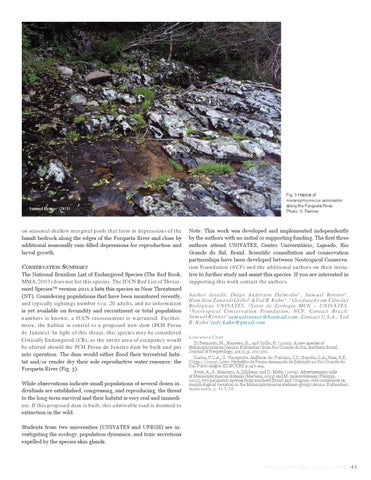Fig. 3 Habitat of
Melanophryniscus admirabilis along the Forqueta River. Photo: S. Renner.
on seasonal shallow marginal pools that form in depressions of the basalt bedrock along the edges of the Forqueta River and close by additional seasonally rain-filled depressions for reproduction and larval growth.
Conservation Summary The National Brazilian List of Endangered Species (The Red Book, MMA ,2003) does not list this species. The IUCN Red List of Threatened Species™ version 2011.2 lists this species as Near Threatened (NT). Considering populations that have been monitored recently, and typically sightings number <ca. 20 adults, and no information is yet available on fecundity and recruitment or total population numbers is known, a IUCN reassessment is warranted. Furthermore, the habitat is central to a proposed new dam (PCH Perau de Janeiro). In light of this threat, this species may be considered Critically Endangered (CR), as the entire area of occupancy would be altered should the PCH Perau de Janeiro dam be built and put into operation. The dam would either flood their terrestrial habitat and/or render dry their sole reproductive water resource; the Forqueta River (Fig. 3). While observations indicate small populations of several dozen individuals are established, congressing, and reproducing, the threat to the long-term survival and their habitat is very real and immediate. If this proposed dam is built, this admirable toad is doomed to extinction in the wild.
Note: This work was developed and implemented independently by the authors with no initial or supporting funding. The first three authors attend UNIVATES, Centro Universitário, Lajeado, Rio Grande do Sul, Brazil. Scientific consultation and conservation partnerships have been developed between Neotropical Conservation Foundation (NCF) and the additional authors on their initiative to further study and assist this species. If you are interested in supporting this work contact the authors. Author details: Diego Anderson Dalmolin¹, Samuel Renner¹, Hamilton Zanardi Grillo² & Ted R. Kahn³. ¹Graduação em Ciências Biológicas UNIVATES. ²Setor de Zoologia MCN – UNIVATES. ³Neotropical Conservation Foundation, NCF. Contact Brazil: Samuel Renner1 samuelrenner@hotmail.com. Contact U.S.A.: Ted R. Kahn3 tedr.kahn@gmail.com Literature Cited Di Bernardo, M., Maneyro, R., and Grillo, H. (2006). A new species of Melanophryniscus (Anura: Bufonidae) from Rio Grande do Sul, southern Brazil. Journal of Herpetology, 40(2), p. 261-266. Garcia, P.C.A.; G. Vinciprova. Anfíbios. In: Fontana, C.S.; Bencke, G.A.; Reis, R.E. (Orgs.). (2003). Livro Vermelho da Fauna Ameaçada de Extinção no Rio Grande do Sul. Porto Alegre: EDIPUCRS p.147-164. Kwet, A., R. Maneyro, A. Zillikens, and D. Mebs. (2005). Advertisement calls of Melanophryniscus dorsalis (Mertens, 1933) and M. montevidensis (Philippi, 1902), two parapatric species from southern Brazil and Uruguay, with comments on morphological variation in the Melanophryniscus stelzneri group (Anura: Bufonidae). Salamandra, p. 41:3–20.
Students from two universities (UNIVATES and UFRGS) are investigating the ecology, population dynamics, and toxic secretions expelled by the species skin glands.
FrogLog Vol. 100 | January 2012 | 41
